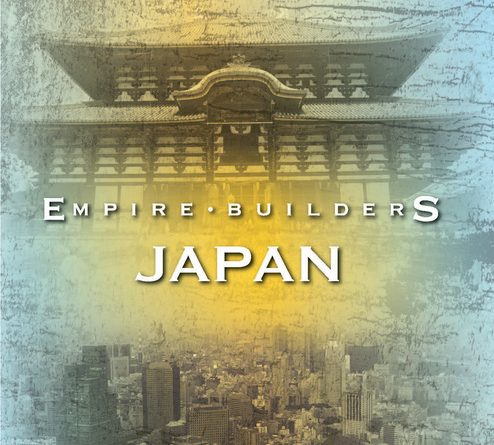
Empire Builders – Japan
In this episode of Empire Builders we explore the remarkable history of one of the world’s most unique and diverse ancient cultures, Japan, travelling through time to explore the past 1500 years of Japan’s history through 10 of its most famous and spectacular buildings.
1. Todai-ji Temple, Nara (752 AD)
The main hall of this most magnificent of Japan’s earliest Buddhist temples houses an enormous Buddha, and was the world’s largest wooden building for nearly 1000 years after its construction.
2. Heian Shrine, Kyoto (794 AD, rebuilt 1895)
Dedicated to the first and last of the more than 50 Japanese Emperors who ruled from Kyoto, the main hall of this beautiful Shinto shrine is a replica of the original Heian Palace, from where Kyoto’s first Emperor ruled.
3. Byodo-in Temple, Uji (1053)
The main Phoenix Hall, an exquisite UNESCO World Heritage Site, is one of Japan’s most remarkable and best-loved buildings. Depicted on Japan’s 10 yen coin, its appearance is said to resemble a phoenix in flight, the bird which symbolises rebirth and reincarnation.
4. Tsurugaoka Hachimangu Shrine, Kamakura (1192)
Built by Japan’s first Shogun, or military leader, this historic shrine is dedicated to the Shinto god of war. Every year ancient ‘Yabusame’ ritual archery is performed here, dating back to the first Shogun’s demand that his Samurai warriors should be expert archers.
5. Himeji Castle (1609)
Built for one of Japan’s many feudal warlords, it was expertly designed to be virtually impregnable against attack, and is today renowned as Japan’s most spectacular castle.
6. Nikko Toshogu Shrine (1617)
Perhaps the most elaborate and splendid of all Japanese shrines, it was created as a mausoleum to honour Japan’s most powerful and famous Shogun, Ieyasu Tokugawa, who unified and pacified the country after centuries of warfare.
7. Dejima Island, Nagasaki (1630s – 1850s)
The Tokugawa shogunate imposed a period of strict national isolation for nearly 250 years, forbidding foreigners to enter Japan, except at this tiny island in Nagasaki bay, where a handful of European traders were allowed to operate.
8. Marunouchi District, Tokyo (1890s)
After the ‘Meiji Restoration’ in 1868 finally overthrew the feudal Tokugawa shogunate, this area of Tokyo adjacent to the Imperial Palace was utterly transformed. Once home to the vast mansions of Japan’s feudal lords, it became Japan’s first modern business district.
9. Hiroshima Atomic Bomb Dome (1945)
After rapidly modernising and militarising in the early 20th Century, Japan emulated the previous actions of Western powers by attempting to create a vast Asian empire through warfare. By 1945 Japan’s aggression was utterly defeated, forced into unconditional surrender by the horrifying effects of the atomic bombs that were dropped on Hiroshima and Nagasaki.
10. Tokyo Skytree Tower (2012)
Rising phoenix-like out of the ashes of war, remarkably within just a few decades Japan was able to become one of the world’s most successful developed modern economies. At over 2000 feet high, the world’s tallest communication tower in Tokyo is a prime symbol of the extraordinary transformation of Japan over the past three quarters of a century since World War Two.
Credits
narrator
BOB BLYTHE
with thanks to
TOKYO CONVENTION & VISITORS BUREAU
MITSUBISHI ICHIGOKAN MUSEUM
TOCHIGI PREFECTURAL FILM COMISSION
NAGASAKI FILM & MEDIA COMMISSION
HIROSHIMA FILM COMMISSION
HIMEJI CONVENTION & VISITORS BUREAU
KYOTO MEDIA SUPPORT CENTRE
BYODO-IN
CITY OF NARA
*
titles & graphics
MARTINA DEO
CGI artist
SIMON ROSS
*
camera
NIGEL KINNINGS
archive
LIBRARY OF CONGRESS
HIMEJI FILM COMMISSION
HIMEJI CITY
*
facilities
GUILTFREE POST
dubbing mixer
CHRIS MORRIS
*
editors
ALEKSANDAR NIKOLIC
online editor
DANNY DAVIS
*
title music
PAUL MOUNSEY
music by
PAUL MOUNSEY
SIMON HILL
MARK TAYLOR
JESPER MATTSSON
NAINITA DESAI
SITTING DUCK
MICHAEL CONN
AMANDA KRAMER
IAN RITCHIE
JON WYGENS
WEST INDIA COMPANY
CONLIN WINSTON FLETCHER
*
post production coordinators
EMILIO REY
JAKE CHRISTIAN
production accountant
RASHIDA PATEL
production manager
TARA BENSON
*
executive producer
IAN CROSS
*
produced and directed by
CHRIS LEDGER
*
Produced by Pilot Film and TV Productions
© Pilot Productions MMXVII
